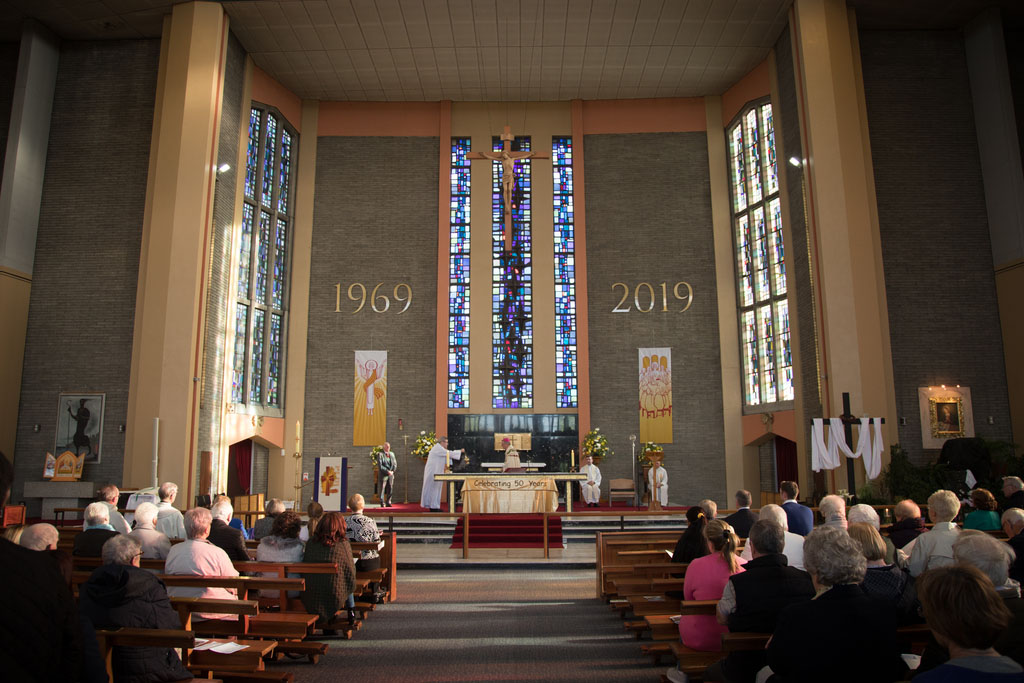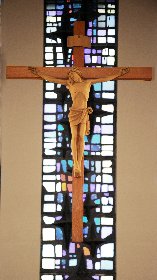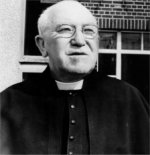
Church History
Details about the History of Donnycarney Parish
Patrician Foundation
 According to the Tripartite Life of St. Patrick, all churches bearing the name of Domnach, Dominica or Sunday were originally founded or pointed out by St. Patrick. There is a tradition that St. Patrick founded such a church in Donnycarney and may have been dedicated to St. Cearnach, a disciple of St. Patrick. Tradition states, that in areas where pagan worship took place a church was built and dedicated on the site.
According to the Tripartite Life of St. Patrick, all churches bearing the name of Domnach, Dominica or Sunday were originally founded or pointed out by St. Patrick. There is a tradition that St. Patrick founded such a church in Donnycarney and may have been dedicated to St. Cearnach, a disciple of St. Patrick. Tradition states, that in areas where pagan worship took place a church was built and dedicated on the site.
The earliest ecclesiastical foundation in the general area was in Glasnevin where there was a famous monastery associated with St. Mobhi. The Annuls of the Four Masters mentions a monastery at Glasnevin in 544. The monastery at Finglas associated with St. Canice and founded in 560 AD eventually absorbed that of Glasnevin.
Since the present Irish name for Donnycarney is Domnach Cearna it has been suggested that there was an early pre-Norman church in Donnycarney that gave rise to this name but there is no evidence for this.
The earliest definite reference to Donnycarney is to be found in a document of 1171, which concerns the possessions of the Augustinian monastery of All Hallows, which stood on the site of what is now Trinity College. Among the possessions confirmed in the possessions of the monastery during Henry II’s stay in Dublin in that year was “Duncarnac”. Duncarnac or Donnycarney, as it was known in English, was part of the parish of Clonturk (“Kanturk”), which had been founded by Diarmuid Mac Murragh, King of Leinster just before the Norman Conquest. This grant was subsequently confirmed by Popes Urban III (1186), Gregory IX (1234) and others.
In addition there is in the register a reference from 1220 to a certain John Latimer, who through divine piety and for the salvation of his own soul and those of his wife and parents granted to All Hallows a parcel of land, which had been a source of contention between the canons and himself, “that is the land that is called Inchenhaven and which lies between Duncharny and the river called Schikeloth”. Inchenhaven (inse na habhann, riverside meadow) was the ground beside the river, later called Silloge, which was submerged in times of flood and is today covered by Collins Avenue East and the church grounds.
17th century Donnycarney
At the end of the 16th century Catholics in the barony of Coolock were without church or chapel, priest’ residences, etc., all was in Protestant hands. They were required in addition to the upkeep or repair of the Protestant churches, give offerings for baptisms and marriages to the Protestant minister, and pay fines for not attending Protestant services. At the same time they had to keep their own clergy. In practice the clergy were kept by the well-to-do catholic families such as the Bathes of Drumcondra and the Hollywoods of Artane and said Mass in their houses.
New Churches
With the occupation of the new housing scheme in Marino (1924) and Donnycarney (1928), this expanding population put a huge burden on the parish church in Fairview. They’re maybe some people still around, who can remember the long trudge from Donnycarney to Fairview in the late 1920’s and the early 1930’s. Canon Flanagan P.P. often expressed in his homilies, the need for a ‘New Church’ to cater for the ever-growing populations in Marino and Donnycarney. The new parish church of St. Vincent de Paul Marino was opened in 1932 and the parishioners from Donnycarney were especially delighted, as the journey was now much shorter. Most people either walked or cycled to the church. However, in the late 1940’s a bus was provided from Hazel Road for Sunday Mass.
Canon Keon was PP in Fairview from 1879 to 1902 and was succeeded by Denis Petit in 1904 until 1928. Canon Flanagan was PP from 1928 until 1936 and was succeeded by Canon McArdle. The new church in Marino was consecrated in 1932 and constituted a parish in 1942 with Canon McArdle as PP. In 1952 the parish of Donnycarney was constituted with Fr. James Robinson as PP.

Early Development
With the occupation of the new housing scheme in Marino (1924) and Donnycarney (1928), this expanding population put a huge burden on the parish church in Fairview. They’re maybe some people still around, who can remember the long trudge from Donnycarney to Fairview in the late 1920’s and the early 1930’s. Canon Flanagan P.P. often expressed in his homilies, the need for a ‘New Church’ to cater for the ever-growing populations in Marino and Donnycarney. The new parish church of St. Vincent de Paul Marino was opened in 1932 and the parishioners from Donnycarney were especially delighted, as the journey was now much shorter. Most people either walked or cycled to the church. However, in the late 1940’s a bus was provided from Hazel Road for Sunday Mass.
Miraculous Painting
In 1938 Canon McArdle P.P. Marino suggested the idea of a new church in Donnycarney and this was enhanced, when the Canon went Budapest, Hungary for the International Eucharistic Congress later in the year. The Canon was in a dilemma as he set out – which dedication he would select for the new church in Donnycarney. 1938 however, was a time of agitation and aggression, with threats of war prevalent everywhere. Into this maelstrom, the Canon along with Bishop Browne of Galway and one hundred Irish pilgrims travelled to Hungary. Stopping in Gyor, Hungary for a connection to Budapest and with time to spare, they went to the Cathedral to view the miraculous painting of Our Lady Comforter of the Afflicted – known as the Weeping Madonna or the Irish Madonna, this painting was originally owned by Bishop Lynch of Clonfert. At the shrine the inspiration was presented to the Canon – dedicate his new church to Our Lady of Consolation.
‘Tin Chapel’
However, the building did not materialise as the Canon wished as World War II intervened. It was postponed until mid 1947, when work began on the erection of our chapel of ease to Marino – “The Tin Chapel”, as it was affectionately known. The church was blessed by Archbishop Mc Quaid and consecrated to Our Lady of Consolation in March 1948. The Canon commissioned a copy of the miraculous painting from Gyor, which was mounted above the side altar. The Bishop of Gyor sent the copy with this prophetic message: “Write soon, for it seems that the night is approaching when no man can work,” – the winds of Communism were then blowing over the land of Hungary and all of Eastern Europe.

New Parish
Donnycarney was constituted a parish in 1952 and the late Very Rev. Fr. James Robinson took up duty as Parish Priest on September 15th of that year. Initially he organised the building of a Parochial Hall, which he dedicated to Our Lady. This was first social amenity in Donnycarney – it was in effect our own ‘Ballroom of Romance’. The memory of Fr. Robinson arriving before the last dance, greeting everyone as he walked up the centre of the hall – the ‘lurchers’ parting quickly. He thanked for coming, as there contributions went to the fund for a new and permanent church. Of course, he asked everyone to say a ‘Hail Mary’ – it may have been a nuisance at the time, but it probably helped some?
The conferring of Parish status on Donnycarney, coincided with the emergence of the great St.Vincent’s and Dublin GAA teams of the 1950’s, many of whom were from the parish i.e. Norman Allen, Tony Young, Bernie Atkins, Des ‘Snitchy’ Ferguson, Mick Moylan, Johnny Joyce, Padraic Haughey and also in soccer, Donnycarney United achieved many honours in this period, with many of their players going on to play with premier club in the League of Ireland.
Burden of Debt
Work began immediately on clearing the debt of £22,000 for the Church and the Hall. The Ladies Committee took on this assignment and through their efforts and the generosity of the parishioners; the debt was cleared very quickly. The ladies continued with their fund raising for a new and permanent Church and their hard work along with the outdoor collectors and many other groups; by 1965 they had generated £65,000 from their efforts – a fantastic achievement. The original estimate for the New Church was £200,000 and a target of £100,000 was set to be collected over the next two years, in order to alleviate the cost of borrowing at high interest rates (16% at the time). A new scheme – planned giving or the envelope collection – took the place of all the other collections. With the parish canvassed, this collection generated £1,000 each week for the following two years and in March 1966 Fr. Robinson turned the ‘First Sod’ for the new church.
New Church Design
The basic plan of the church is cruciform in shape and although modern in design, it was influenced by later medieval churches with its tall pointed windows and arched doorways and its variation in ceiling levels. It was described as Modern Gothic and was designed by Mr. T.P. Kennedy B.Arch., and the builder was Messrs. John Du Moulin and Son. The wonderful and beautiful stained glass windows were designed and executed by Murphy Davitt Studios and Mr. Paul Meehan designed the copper-faced doors, which depict scenes from the New Testament.
Planned Giving
In 1967, the parish decided to dispense with the consultancy company operating the planned giving campaign due to its cost. Donnycarney became the first parish in the diocese to run its own operation. However, the final cost rose to £ 295,000 due to changes in the plans by Dublin Corporation and increases in labour and materials costs. On May 4th 1969, the Church was blessed and dedicated by Archbishop Mc Quaid and Fr. Robinson said the first Mass before a packed congregation. In his homily he praised the parishioners for their fortitude and generosity in completing his life-long ambition.
Parish Priests
 On October 12th 1972 in a circular to the parish, the Parish Priest expressed his gratitude for the continued support for the envelope collection and his wish was, to see the debt on the church cleared. Two days later after a short illness, Fr. Robinson passed away in St. Vincent’s Hospital. He was buried in the grounds of his beloved church after a concelebrated Mass, presided over by Archbishop Dermot Ryan. One parishioner relates, on meeting Fr. Robinson at the Church door. He enquired “if she would be long at her prayers”. She stated that she only doing the Stations of the Cross. To which, Fr. Robinson requested that she should run him home and assured her, that she would get a greater indulgence for this errand.
On October 12th 1972 in a circular to the parish, the Parish Priest expressed his gratitude for the continued support for the envelope collection and his wish was, to see the debt on the church cleared. Two days later after a short illness, Fr. Robinson passed away in St. Vincent’s Hospital. He was buried in the grounds of his beloved church after a concelebrated Mass, presided over by Archbishop Dermot Ryan. One parishioner relates, on meeting Fr. Robinson at the Church door. He enquired “if she would be long at her prayers”. She stated that she only doing the Stations of the Cross. To which, Fr. Robinson requested that she should run him home and assured her, that she would get a greater indulgence for this errand.
In December 1972, Fr. Richard Quigley came to Donnycarney as P.P. and continued the work his predecessor had started and within the next ten years, the parish debt was cleared. It was a tremendous achievement by everyone concerned. Now Fr. Quigley had a new task – as Canon Flanagan and Msgr. Mc Ardle had before him – the building of a new church in Beaumont for the expanding area of Beaumont, Ardmore/Montrose. The new Church of the Nativity, Beaumont was dedicated and constituted a parish on 18th December 1977.
Fr. Quigley passed away suddenly in June 1985 and his passing was a terrible shock to everyone. Many parish projects flourished with his active support and encouragement. His Mass however were often slow affairs and hence he was affectionately christened Fr. Quickly. Fr. Noel Madden became P.P. in August 1985 and has continued the good works of his predecessors over the past twenty years and is due to retire next year. He celebrated his golden jubilee of his ordination recently – a lifetime of tremendous service. Fr. Peter Finnerty who came to the Parish in July 2005 to replace Fr. Anthony Kelly, will take over as PP next year

